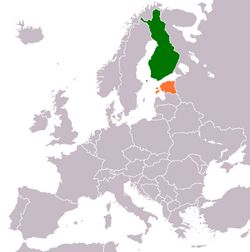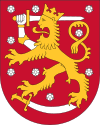Estonia–Finland relations
 | |
Finland |
Estonia |
|---|---|
Estonia–Finland relations are foreign relations between Finland and Estonia. Both countries restored diplomatic relations on 29 August 1991. Finland has an embassy in Tallinn and an honorary consulate in Tartu. Estonia has an embassy in Helsinki and five honorary consulates, located in Oulu, Turku, Ekenäs, Tampere and Kotka. Both countries are full members of the Council of the Baltic Sea States, European Union and the Eurozone.
The majority languages in both countries are Finnic languages, as Finland's main language, Finnish, is related to Estonian, and there is and has been a certain feeling of kinship. 76% of Finns have visited Estonia, and in 2004, 1.8 million Finns reported visiting Estonia. The excise tax on alcohol is lower in Estonia than in Finland, thus it is common to buy large volumes of alcohol when returning from Estonia: a study in 2014 indicated that 34% of alcohol sold in Estonia is bought by Finns.[1] Finnish and Swedish investors are the largest foreign investors in Estonia.[2] Both Finland and Estonia are members of the European Union, Schengen agreement and the Eurozone, freeing international travel and trade between the countries. Finland is Estonia's top import partner, accounting for over 15% total import value in 2012, as well as the second-greatest market for Estonia's exports after Sweden. Finland's government recognised Estonia's independence in 1920. In response to the Soviet invasion, diplomatic missions were de facto removed. However, when Estonia restored its independence, this "temporary obstruction" was resolved. Finland contributed and continues to contribute military aid to Estonia, such as officers' training, and the provision of equipment.

History[]
Unification proposals[]
In Finland, the idea of a unified Greater Finland gained popularity and influence rapidly in 1917, but lost support after World War II and the Continuation War.
In 1917, 1918 and 1940, the Estonian president Konstantin Päts wished for a union of Finnic countries in his political testament, writing an outline of a unification plan. He used the term "soomesugu" in Estonian to point to the people and countries of Finland and Estonia when talking about common border law.[3][4]
Anthem[]
The Finnish anthem Maamme and the similarly themed Estonian anthem Mu isamaa, mu õnn ja rõõm (My Fatherland, My Happiness and Joy, 1869) share the same melody.
This song is also considered to be the ethnic anthem of Livonians, titled Min izāmō, min sindimō (My Fatherland, My Native Land).
Regional cooperation[]
Finnish and Swedish investors are the largest foreign investors in Estonia.[2] Both Finland and Estonia are members of the European Union, Schengen agreement and the Eurozone. Finland is Estonia's top import partner, accounting for over 15% total import value in 2012, as well as the second-greatest market for Estonia's exports after Sweden.
Finland's government recognised Estonia's independence in 1920. Finland contributed and continues to contribute military aid to Estonia, such as officers' training, and the provision of equipment.
Country comparison[]



| Coat of Arms | 
|

|
| Population | 1,318,705 | 5,509,717 |
| Area | 45,227 km2 | 338,424 km2 |
| Population Density | 29/km2 | 18/km2 |
| Capital city | Tallinn | Helsinki |
| Largest Cities | Tallinn – 449,160 (610,468 Metro) Tartu - 99,429 Narva - 58,610 Pärnu - 51,649 Kohtla-Järve - 37,201 |
Helsinki – 621,863 (1,420,576 Metro) Tampere - 223,035 (389,896 Metro) Turku - 191,123 (328,168 Metro) Oulu - 196,260 (241,106 Metro) Jyväskylä - 135,762 (179,410 Metro) |
| Government | Parliamentary representative democratic republic | Parliamentary representative democratic republic |
| First Leader | Konstantin Päts | Pehr Evind Svinhufvud |
| Current Leader | Alar Karis (President) Kaja Kallas (Prime Minister) |
Sauli Niinistö (President) Sanna Marin (Prime Minister) |
| Main Language | Estonian | Finnish and Swedish |
| Main Religions | 54.14% Non-Religious 26.46% Christian 16.55% Undeclared 3.25% Other |
76.5% Christian 22.1% Non-Religious 1.4% Other |
| GDP (nominal) | US$25.42 billion | $300 billion |
| GDP (nominal) per capita | US$19,328 | $54,499 |
| GDP (PPP) | US$34.4 billion | $250 billion |
| GDP (PPP) per capita | US$26,052 | $45,454 |
| Real GDP Growth Rate | 1.50% | -0.6% |
| Military Expenditure | 2% of GDP | 1.47% of GDP |
| Military Personnel | 47,750 | 365,000 |
| Labour Force | 692,900 | 2,685,000 |
| Mobile Phones | 2,070,000 | 9,310,000 |
| Expatriate populations | 7,635 | 100,000 |
Diplomacy[]
See also[]
- Foreign relations of Estonia
- Foreign relations of Finland
- Finnish–Estonian defence cooperation
- Finnish Infantry Regiment 200
- Estonians in Finland
References[]
- ^ "Third of Estonia's Alcohol Sales Attributed to Finnish Tourists". News.err.ee. 22 April 2014.
- ^ a b "Poliittiset suhteet - Suomen suurlähetystö, Tallinna". 10 June 2007. Archived from the original on 10 June 2007. Retrieved 11 January 2018.
- ^ "Archived copy" (PDF). Archived from the original (PDF) on 2016-12-22. Retrieved 2017-01-05.
{{cite web}}: CS1 maint: archived copy as title (link) - ^ "Kuidas Konstantin Päts Eesti-Soome liitriiki soovis". Ohtuleht.ee. Retrieved 11 January 2018.
External links[]
- Estonia–Finland relations
- Bilateral relations of Finland
- Bilateral relations of Estonia

